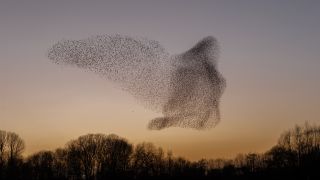Mindfulness
Synchronicity: Enhance Well-Being via Meaningful Coincidences
The concept of synchronicity can deepen self-awareness.
Posted June 2, 2023 Reviewed by Vanessa Lancaster
Key points
- Synchronicity represents meaningful coincidences, suggesting the possibility of an interconnected universe.
- Engaging with synchronicity aids in rewilding the psyche.
- Our ancestors, less distracted, were intuitively attuned to synchronicity and its significance.
- Recognizing synchronicity can enhance well-being, guide personal growth, and foster the antifragile mindset.

Imagine a scenario: you've been wrestling with a significant decision for weeks, then unexpectedly, a conversation overheard in a café provides the clarity you've been seeking. This isn't a carefully scripted scene from a movie, but a real-world instance of what psychiatrist Carl Jung described as synchronicity.1 This concept aligns closely with the idea of "rewilding" the human psyche, a process of returning to a more intuitive and nature-connected state of mind.
Understanding synchronicity
Jung coined the term "synchronicity" to illustrate the phenomenon of "meaningful coincidences," where events are connected by meaning rather than causality. This principle suggests an underlying pattern or interconnectedness in the universe that transcends conventional understandings of cause and effect. Some theories, borrowing from quantum mechanics, even speculate that such synchronicities could be related to phenomena like entanglement, where particles remain connected regardless of the distance between them.2 Groundbreaking experiments by Nobel laureates Alain Aspect, John Clauser, and Anton Zeilinger have advanced our understanding of such quantum phenomena.3 While far from universally accepted, these ideas challenge us to reconsider our perception of reality and the fabric of the universe.
Synchronicity, rewilding, and the antifragile mindset
Rewilding the human psyche involves re-establishing our connection with aspects of our humanity that have been suppressed or forgotten in the fast-paced modern world. This process resonates with the concept of synchronicity. Engaging with synchronicity can help us recognize our interdependence and ultimately support the development of an antifragile mindset.

Our ancestors, living in greater harmony with nature and less distracted by modern phenomena like social media, were intuitively attuned to the mystical and symbolic aspects of life, including synchronicity. They perceived their existence as part of a larger, interconnected whole. In today's world, by recognizing and reflecting upon synchronicities, we can rewild our psyches, reviving this deep-seated awareness of interconnectedness and the significance of meaningful coincidences.
Coined by Nassim Nicholas Taleb, "antifragility" describes the ability to improve and grow from stressors, shocks, and failures.4 I began applying the concept of antifragility to the human psyche during the early days of the pandemic and have since theorized that we have the capacity to embody antifragility because we are interdependent with all that is. Some of the components that enable us to develop antifragile mindsets include our character strengths, experiences in and with nature, our personal narratives, and our ability to anticipate. All of these arise because we are part of a greater whole.5 Realization of our interdependence supports our ability to recognize synchronicities. And simultaneously, recognizing synchronicities supports our ability to awaken to our interdependence. By understanding and interpreting synchronicities, especially during periods of change or uncertainty, we can guide our personal growth and become more antifragile.
Synchronicity offers valuable pathways with which we can enrich our well-being:
- Illuminates guidance. Synchronicities can serve as subtle signposts when navigating life's crossroads.
- Enhances self-awareness. Reflecting on synchronicities can reveal deeper thoughts and emotions.
- Fosters connection. Encountering synchronicities can strengthen our sense of interconnectedness with the world.

Harnessing the power of synchronicity
The following suggestions will help you engage with the power of synchronicity:
- Cultivate mindfulness. Slow down and practice mindfulness. Mindfulness enhances our capacity to notice and appreciate synchronicities.
- Keep a synchronicity journal. Documenting synchronistic events can highlight patterns and themes.
- Reflect and interpret. Set aside time to contemplate the significance of synchronistic events in your life.
- Foster openness and curiosity. Embrace synchronicities with an open heart and curious mind.
- Support your understanding by learning more about synchronicity or joining an organization such as The Coincidence Project,6 founded by fellow Psychology Today blogger Bernard Beitman. The project explores the science of synchronicity and serendipity.
Synchronicity invites us to experience a world where internal and external realities intertwine in remarkable ways. By recognizing and reflecting on these meaningful coincidences, we take strides in the process of rewilding our psyches, reconnecting with the intuitive understanding of interconnectedness that our ancestors naturally possessed. Simultaneously, this practice allows us to cultivate an antifragile mindset, turning perceived challenges into opportunities for growth. The next time an unusual coincidence catches your attention, take a moment to appreciate it–it might just be a whisper from the universe, gently guiding your path.
References
1. Jung, C. G. (1952). "Synchronicity: An Acausal Connecting Principle." In Collected Works vol. 8. Princeton, NJ: Princeton University Press.
2. Goswami, A. (1995). The Self-Aware Universe: How Consciousness Creates the Material World. Penguin.
3. The Nobel Prize in Physics 2022, https://www.nobelprize.org/prizes/physics/2022/popular-information/
4. Taleb, N.N. (2012). Antifragile: Things that gain from disorder. New York: Random House.
5. Klisanin, D. (2022). "Psychological Futures: Antifragility and the imperitive of interdependence." In Eds. Donnelley, G. and Montuori, A., Routledge Handbook for Creative Futures. Routledge.
6. The Coincidence Project, https://thecoincidenceproject.net/about-us/


